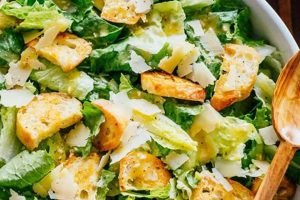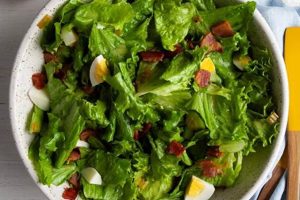Seasonal salads featuring hearty, cold-weather produce offer a refreshing counterpoint to heavier winter meals. Root vegetables like beets, carrots, and parsnips, combined with sturdy greens such as kale or radicchio, form the base of these dishes. Citrus fruits, nuts, seeds, dried cranberries, and cheeses provide contrasting textures and flavors. A simple vinaigrette or a creamy dressing complements these robust ingredients. For instance, a salad combining roasted butternut squash, kale, goat cheese, and toasted pecans with a maple-balsamic vinaigrette exemplifies this category.
These dishes provide essential vitamins and minerals during months when fresh produce can be less readily available. They offer a lighter alternative to rich, calorie-dense winter comfort foods, contributing to a balanced diet. Historically, winter salads relied on preserved produce and root cellars, evolving with culinary trends to incorporate diverse ingredients and global influences.
The following sections explore specific components of crafting delicious cold-weather salads, including ingredient selection, preparation techniques, and dressing options.
Tips for Crafting Winter Salads
Creating vibrant and satisfying cold-weather salads requires careful consideration of ingredients and techniques. These tips offer guidance for composing balanced and flavorful dishes.
Tip 1: Embrace Seasonal Produce: Select peak-season fruits and vegetables for optimal flavor and nutritional value. Look for winter squash, root vegetables, citrus fruits, and hearty greens like kale or cabbage.
Tip 2: Roast Root Vegetables: Roasting enhances the natural sweetness and adds depth of flavor to root vegetables like beets, carrots, and parsnips. Toss them with olive oil, herbs, and spices before roasting.
Tip 3: Incorporate Textural Variety: Add nuts, seeds, dried fruits, or croutons for contrasting textures. Toasted pecans, walnuts, or pumpkin seeds provide satisfying crunch.
Tip 4: Balance Flavors: Consider the balance of sweet, savory, acidic, and bitter elements. Pair sweet roasted vegetables with tangy citrus segments or peppery arugula.
Tip 5: Choose Complementary Dressings: Opt for dressings that enhance the flavors of the salad components. A citrus vinaigrette, creamy tahini dressing, or a simple balsamic glaze can all work well.
Tip 6: Don’t Overcrowd the Plate: Allow each ingredient to shine by avoiding overcrowding. A well-composed salad showcases the individual flavors and textures.
Tip 7: Prepare Ingredients in Advance: Roasting vegetables, making dressings, and washing greens ahead of time streamlines assembly.
By following these tips, one can create flavorful, nutritious, and visually appealing salads that showcase the best of winter’s bounty.
The following section offers specific recipe ideas to inspire culinary creativity.
1. Seasonal Ingredients
Seasonality forms the cornerstone of a successful winter salad. Utilizing produce at its peak ripeness guarantees optimal flavor and nutritional value. Winter offers an array of unique ingredients, including root vegetables like beets, carrots, and parsnips, hearty greens such as kale and cabbage, and citrus fruits like oranges and grapefruits. These ingredients not only provide distinct flavors and textures but also contribute essential vitamins and minerals to the diet. The inherent sweetness of roasted root vegetables, the peppery bite of kale, and the bright acidity of citrus create a balanced and complex flavor profile characteristic of a well-composed winter salad. For example, a salad featuring roasted butternut squash with pecans, cranberries, and kale offers a symphony of flavors and textures unique to the season.
Prioritizing seasonal ingredients strengthens the connection between the dish and the natural world. Choosing locally sourced, seasonal produce reduces transportation costs and environmental impact while supporting local farmers. Furthermore, embracing seasonality encourages culinary creativity and allows for exploration of diverse flavors and textures. One might experiment with different varieties of winter squash, such as kabocha or delicata, each offering unique characteristics that enhance the salad. Incorporating seasonal fruits like pears or pomegranates adds sweetness and visual appeal.
In summary, the emphasis on seasonal ingredients in winter salads offers numerous benefits. From maximizing flavor and nutritional content to promoting sustainable practices and fostering culinary innovation, seasonality serves as a guiding principle for crafting exceptional winter salads. Understanding the nuances of each ingredient and how they interact within the composition elevates the dish from a simple combination of components to a celebration of winter’s bounty.
2. Flavor Balance
Flavor balance is paramount in crafting successful winter salads. The inherent density of winter produce necessitates careful consideration of contrasting and complementary flavors to avoid monotony. A well-balanced salad engages the palate with a complex interplay of tastes, ensuring a satisfying and enjoyable culinary experience.
- Sweetness and Acidity
The natural sweetness of roasted root vegetables, such as butternut squash or beets, harmonizes with the bright acidity of citrus fruits like oranges or grapefruit. This interplay prevents the salad from becoming overly sweet or cloying, creating a refreshing contrast that awakens the taste buds. A balsamic glaze can further enhance the sweet and acidic notes.
- Earthiness and Brightness
Hearty winter greens, like kale or radicchio, often possess an earthy, slightly bitter flavor. Balancing this earthiness with brighter elements, such as pomegranate seeds, dried cranberries, or a citrus vinaigrette, adds dimension and complexity. This contrast prevents the salad from feeling too heavy or one-dimensional.
- Creaminess and Crunch
Incorporating creamy elements, such as goat cheese, crumbled feta, or a tahini dressing, provides a textural and flavor counterpoint to crunchy components like toasted nuts, seeds, or croutons. This interplay of textures and flavors adds interest and prevents the salad from becoming monotonous.
- Spice and Warmth
Integrating spices like ginger, cinnamon, or nutmeg into roasted vegetables or dressings introduces warmth and complexity. These warming spices complement the cooler elements of the salad, creating a balanced and inviting flavor profile. For example, a sprinkle of cinnamon on roasted sweet potatoes adds depth and complexity.
By strategically combining these contrasting yet complementary flavors, a winter salad transforms into a vibrant and nuanced culinary experience. The balance achieved not only enhances the enjoyment of the dish but also highlights the inherent qualities of each ingredient, showcasing the bounty of winter produce in a harmonious and delectable manner. This careful orchestration of flavors elevates the salad beyond a simple combination of ingredients, transforming it into a sophisticated and satisfying culinary creation.
3. Textural Contrast
Textural contrast contributes significantly to the overall enjoyment of a winter salad. The density and heartiness often associated with winter produce require a considered approach to texture to prevent the dish from feeling heavy or monotonous. A dynamic interplay of textures elevates the sensory experience, making each bite more engaging and satisfying. This contrast can be achieved through various techniques and ingredient choices, transforming a simple salad into a multi-dimensional culinary creation.
Crispy elements provide a counterpoint to softer, roasted vegetables. Toasted nuts, such as pecans, walnuts, or hazelnuts, offer a satisfying crunch. Seeds, like pumpkin or sunflower seeds, contribute a delicate crispness. Croutons, either homemade or store-bought, provide a substantial crunch and can be flavored with herbs and spices to complement the other salad components. Furthermore, raw vegetables, such as thinly sliced fennel, shredded carrots, or chopped celery, introduce a refreshing crispness that contrasts with the softer textures of roasted or cooked ingredients. A salad featuring roasted butternut squash, kale, and toasted pecans with a maple-balsamic vinaigrette exemplifies this principle, offering a delightful interplay of textures.
The strategic inclusion of contrasting textures not only enhances the sensory experience but also impacts the overall perception of flavor. The interplay of textures stimulates the palate, allowing for a more nuanced appreciation of the individual ingredients. A salad lacking textural variety may taste bland, even if the flavors are well-balanced. Therefore, understanding the importance of textural contrast is essential for creating successful winter salads. By thoughtfully combining ingredients with varying textures, one can elevate a simple salad to a complex and satisfying culinary experience.
4. Hearty Components
Hearty components form the foundation of a satisfying winter salad, providing substance and satiety. Unlike lighter salads composed primarily of leafy greens, winter salads often incorporate roasted root vegetables, grains, legumes, or winter squash as central elements. These ingredients offer textural complexity and contribute significantly to the salad’s nutritional value. Roasted sweet potatoes, for instance, provide sweetness, vitamins, and a substantial textural presence. Similarly, the inclusion of cooked quinoa or lentils adds protein and fiber, transforming the salad into a more complete meal. The presence of these hearty components distinguishes winter salads from their lighter counterparts, making them appropriate for colder weather and more substantial meals.
The selection of hearty components influences the overall flavor profile and nutritional density of the salad. Root vegetables like roasted beets or parsnips provide earthy sweetness and essential nutrients. Adding grains, such as farro or barley, introduces nutty flavors and fiber. Legumes, like chickpeas or black beans, contribute protein and textural variety. These choices offer flexibility for customization, catering to individual dietary preferences and nutritional needs. For example, a winter salad featuring roasted butternut squash, kale, and chickpeas with a tahini dressing offers a balanced combination of flavors, textures, and nutrients. This approach elevates the salad from a side dish to a main course, providing a complete and satisfying meal.
Incorporating hearty components allows winter salads to serve as substantial and nourishing meals. These components provide sustained energy and essential nutrients, aligning with the need for more calorie-dense foods during colder months. The versatility of these ingredients allows for endless variations and flavor combinations, ensuring that winter salads remain interesting and appealing throughout the season. The ability to customize the hearty components allows for adaptability to dietary restrictions and preferences, making winter salads an inclusive and accessible culinary option. Furthermore, this focus on hearty elements allows for the seamless integration of seasonal produce, highlighting the best of winter’s bounty.
5. Versatile Dressings
The role of dressings in winter salads extends beyond simply adding moisture. Dressings provide a crucial bridge, uniting the diverse flavors and textures characteristic of these salads. A versatile dressing complements, rather than overpowers, the inherent qualities of winter produce. The density and earthiness of root vegetables, the slight bitterness of hearty greens, and the sweetness of dried fruits or nuts require dressings that enhance, rather than mask, these flavors. The choice of dressing significantly influences the overall balance and complexity of the salad. For example, a citrus vinaigrette, with its bright acidity, cuts through the richness of roasted butternut squash, while a creamy tahini dressing complements the earthiness of kale and roasted chickpeas. The interplay between the dressing and the other salad components creates a harmonious and nuanced flavor profile.
The versatility of a dressing lies in its adaptability to different flavor profiles and ingredient combinations. A well-chosen dressing can transform a simple salad into a sophisticated culinary creation. Vinaigrettes, with their balance of oil and acid, offer a light and refreshing counterpoint to the density of winter vegetables. The addition of herbs, spices, or fruit juices further enhances their versatility. Creamy dressings, such as those based on yogurt, tahini, or buttermilk, provide a richer and more decadent element, complementing roasted vegetables and hearty greens. The ability to adjust the consistency and flavor profile of these dressings through the addition of herbs, spices, or other ingredients contributes to their adaptability. Furthermore, the choice of dressing can also reflect dietary considerations, with options available for vegan, gluten-free, or low-fat diets. For example, a maple-Dijon vinaigrette offers a vegan and gluten-free option that complements roasted root vegetables.
Understanding the integral role of dressings in winter salad recipes allows for greater culinary control and creativity. Strategic dressing selection elevates the salad from a simple combination of ingredients to a carefully composed dish with balanced flavors and textures. The adaptability of versatile dressings facilitates exploration of diverse flavor profiles and culinary traditions. By recognizing the importance of this component, one can fully realize the potential of winter salads as both nourishing and flavorful culinary expressions. This understanding unlocks the ability to tailor dressings to specific ingredient combinations, dietary needs, and desired flavor profiles, transforming the winter salad experience.
Frequently Asked Questions
This section addresses common inquiries regarding the creation of satisfying and flavorful winter salads.
Question 1: How can one prevent winter salads from feeling too heavy or dense?
Balance is key. Incorporate lighter elements like fresh herbs, citrus segments, or crunchy nuts and seeds to offset the density of roasted vegetables or grains. A bright vinaigrette also helps lighten the overall impression.
Question 2: What are suitable substitutes for ingredients not readily available during winter?
Flexibility is encouraged. If a specific winter vegetable is unavailable, consider substituting a similar root vegetable or hearty green. Canned or frozen options can be utilized, though fresh, seasonal produce is generally preferred for optimal flavor and nutritional value.
Question 3: How can one ensure a winter salad provides adequate nutrition?
Incorporate a variety of ingredients. Include protein sources such as beans, lentils, nuts, seeds, or cheese. Add whole grains like quinoa or farro for complex carbohydrates and fiber. The diversity of vegetables and fruits contributes essential vitamins and minerals.
Question 4: What are effective methods for preparing root vegetables for winter salads?
Roasting enhances the natural sweetness of root vegetables. Toss them with olive oil, herbs, and spices before roasting until tender. Alternatively, root vegetables can be boiled or steamed until tender, then added to the salad.
Question 5: Can winter salads be made ahead of time?
Components can be prepared in advance. Roast vegetables, cook grains, and make dressings a day or two ahead. Store these elements separately and combine them just before serving to maintain optimal texture and freshness. Leafy greens should be added just before serving to prevent wilting.
Question 6: How can one adapt winter salad recipes to different dietary restrictions?
Substitutions are readily available. For gluten-free diets, ensure grains and dressings are gluten-free. Vegan diets can utilize plant-based proteins, such as beans, lentils, tofu, or tempeh, and avoid dairy-based dressings and cheeses. Adjustments to oil content or types can address fat or calorie restrictions.
Crafting successful winter salads involves understanding seasonal ingredients, balancing flavors, and considering textural variety. Prioritizing fresh, seasonal produce ensures optimal flavor and nutritional value.
The following section provides a collection of inspiring winter salad recipes.
Conclusion
Exploration of cold-weather salad composition reveals the importance of seasonality, flavor balance, textural contrast, and the strategic incorporation of hearty components and versatile dressings. Prioritizing fresh, locally sourced produce not only maximizes flavor and nutritional value but also supports sustainable agricultural practices. Careful consideration of these elements allows for the creation of salads that showcase the unique bounty of winter while providing satisfying and nutritionally balanced meals.
The adaptability of these dishes offers a canvas for culinary creativity, encouraging exploration of diverse flavor profiles and ingredient combinations. Continued experimentation with seasonal produce and innovative dressing combinations promises to further expand the possibilities of cold-weather salads, solidifying their role as a vibrant and essential component of a balanced winter diet.






